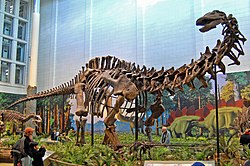Apatosaurus
|
Apatosaurus Temporal range: Tithonian, 152–151 Ma |
|
|---|---|
 |
|
| Mounted A. louisae holotype (specimen CM 3018), Carnegie Museum of Natural History | |
| Scientific classification | |
| Kingdom: | Animalia |
| Phylum: | Chordata |
| Class: | Reptilia |
| Clade: | Dinosauria |
| Order: | Saurischia |
| Suborder: | †Sauropodomorpha |
| Clade: | †Neosauropoda |
| Family: | †Diplodocidae |
| Subfamily: | †Apatosaurinae |
| Genus: |
†Apatosaurus Marsh, 1877 |
| Type species | |
|
†Apatosaurus ajax Marsh, 1877 |
|
| Referred Species | |
|
|
Apatosaurus (/əˌpætəˈsɔːrəs/; meaning "deceptive lizard") is a genus of extinct sauropod dinosaurs that lived in North America during the Late Jurassic period. Othniel Charles Marsh described and named the first-known species, A. ajax in 1877, and a second species, A. louisae, was discovered and named by William H. Holland in 1916. They lived about 152 to 151 million years ago (mya), during the early Tithonian age, and are now known from fossils in the Morrison Formation of modern-day Colorado, Oklahoma, and Utah, in the United States. Apatosaurus had an average length of 21–22.8 m (69–75 ft), and an average mass of 16.4–22.4 t (16.1–22.0 long tons; 18.1–24.7 short tons). A few specimens indicate a maximum length of 11–30% greater than average and a mass of 32.7–72.6 t (32.2–71.5 long tons; 36.0–80.0 short tons).
The cervical vertebrae of Apatosaurus are less elongated and more heavily constructed than those of Diplodocus, a diplodocid like Apatosaurus, and the bones of the leg are much stockier despite being longer, implying that Apatosaurus was a more robust animal. The tail was held above the ground during normal locomotion. Apatosaurus had a single claw on each forelimb and three on each hindlimb. The skull of Apatosaurus, long thought to be similar to Camarasaurus, is much more similar to that of Diplodocus. Apatosaurus was a generalized browser that likely held its head elevated. To lighten its vertebrae, Apatosaurus had air sacs that made the bones internally full of holes. Like that of other diplodocids, its tail may have been used as a whip to create loud noises.
...
Wikipedia
